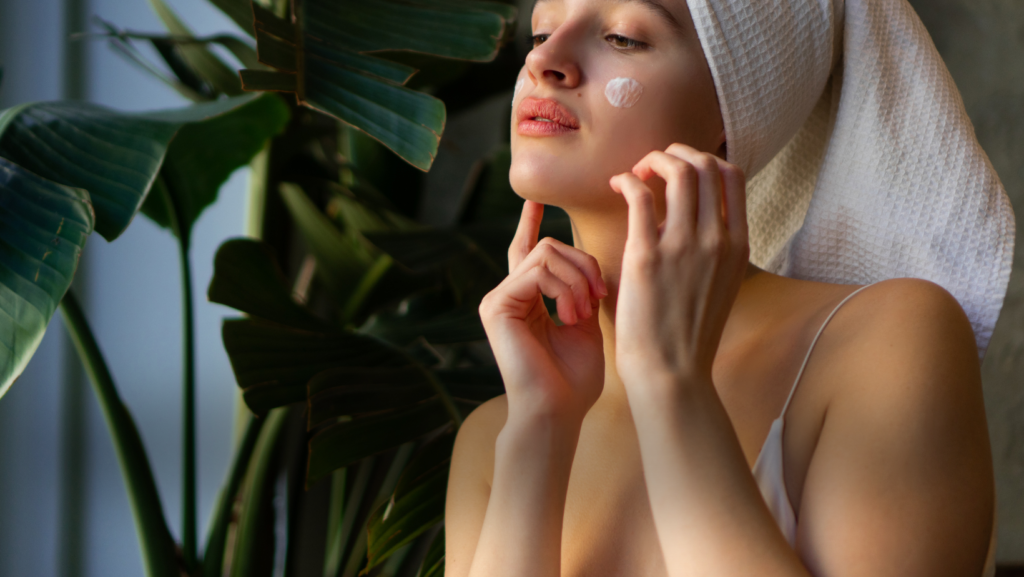Red, irritated skin is frustrating. I’ve been there—waking up to flare-ups, trying endless products, and wondering, what skin care helps with redness? After lots of trial and error, I finally found what works. The right ingredients and simple routines can make a huge difference. In this guide, I’ll share easy tips to calm your skin and keep redness away. Let’s get started!
Understanding Skin Redness
If your skin often looks flushed, irritated, or patchy, you’re not alone. Redness can pop up for many reasons—sometimes out of nowhere—and it’s frustrating to deal with. I remember looking in the mirror, wondering why my face looked so inflamed, even when I was using “gentle” products. Turns out, there’s more to redness than just sensitive skin. Let’s break it down.

What Causes Skin Redness?
Skin redness happens when blood vessels under the skin expand or when the skin barrier gets damaged. Some common triggers include:
- Sensitive Skin: Some people naturally have skin that reacts easily to products, weather, or even stress.
- Rosacea: A chronic condition that causes redness, visible blood vessels, and sometimes bumps.
- Inflammation & Irritation: This can come from harsh skincare, allergies, or even environmental factors like wind and pollution.
- Over-Exfoliation: Too many acids, scrubs, or peels can strip your skin and lead to irritation.
- Allergic Reactions: Some ingredients—like fragrance or alcohol—can trigger redness in certain people.
💡 Short answer: Skin redness is usually caused by irritation, sensitivity, or underlying conditions like rosacea.
How to Identify the Cause of Your Redness
Pinpointing the root cause of redness can help you manage it better. Here’s how:
- Track Your Triggers: Pay attention to when redness flares up. Is it after using a new product? Eating spicy food? Exposure to the sun?
- Look for Patterns: If redness appears with small bumps, it could be rosacea. If it burns after applying skincare, it might be irritation.
- Test Products One at a Time: If you suspect a product is the culprit, stop using it for a few days and see if your skin improves.
- Check Your Environment: Dry air, pollution, and even hot showers can cause redness.
💡 Short answer: Identify redness triggers by tracking skincare, diet, and environmental changes.
When to See a Dermatologist
If your redness doesn’t go away, keeps getting worse, or is painful, it’s best to see a dermatologist. They can check if it’s rosacea, eczema, or another skin condition that needs special treatment.
💡 Short answer: If redness is persistent, painful, or worsening, a dermatologist can help with proper diagnosis and treatment.
Best Skin Care Ingredients for Redness Relief
Choosing the right skincare ingredients can make a world of difference. Here are the best ones to look for:
Soothing Ingredients
- Aloe Vera – Instantly cools and hydrates the skin.
- Green Tea Extract – Reduces inflammation and protects against damage.
- Chamomile – Calms irritation and soothes sensitive skin.
- Centella Asiatica – Helps with healing and reduces redness.
💡 Short answer: Aloe vera, green tea, chamomile, and Centella Asiatica help soothe and calm red, irritated skin.
Barrier-Repairing Ingredients
- Ceramides – Strengthen the skin barrier to lock in moisture.
- Niacinamide – Reduces inflammation, redness, and improves skin texture.
- Hyaluronic Acid – Provides deep hydration to prevent dryness and irritation.
💡 Short answer: Ceramides, niacinamide, and hyaluronic acid help repair and protect the skin barrier.
Anti-Inflammatory Ingredients
- Colloidal Oatmeal – Relieves itchiness and irritation.
- Licorice Extract – Brightens skin while reducing redness.
💡 Short answer: Colloidal oatmeal and licorice extract help calm inflammation and redness.
Best Skin Care Products to Reduce Redness
Finding the right products can be tricky. Some cleansers make redness worse. Some toners sting. I’ve been there! But once I found gentle, soothing products, my skin felt better. Here’s what helps.
Cleansers: Gentle and Sulfate-Free
A harsh cleanser can strip your skin. That makes redness worse. Instead, use a mild, non-foaming cleanser that cleans without irritation. Look for:
✔ Creamy or gel-based formulas
✔ Fragrance-free and alcohol-free options
✔ Aloe vera, oat extract, or glycerin
💡 Use a gentle, sulfate-free cleanser to calm red skin.
Toners & Serums: Calming and Alcohol-Free
Toners and serums should soothe, not burn. The best ones reduce redness and protect your skin. Look for:
✔ Niacinamide: Calms irritation and strengthens skin.
✔ Centella Asiatica: Heals and soothes.
✔ Green Tea Extract: Reduces swelling and protects skin.
💡 Pick a toner or serum with niacinamide, Centella Asiatica, or green tea.
Moisturizers: Hydrating and Barrier-Repairing
A good moisturizer locks in moisture and repairs your skin. The best ones have:
✔ Ceramides: Strengthen the skin barrier.
✔ Hyaluronic Acid: Keeps skin soft and hydrated.
✔ Colloidal Oatmeal: Soothes itchy, irritated skin.
💡 Use a moisturizer with ceramides and hyaluronic acid to repair your skin barrier.
SPF: Mineral Sunscreens for Protection
The sun can make redness worse. A mineral sunscreen is gentle and safe for sensitive skin. Look for:
✔ SPF 30 or higher
✔ Zinc oxide or titanium dioxide
✔ No fragrance or alcohol
💡 Use a mineral sunscreen daily to protect red, sensitive skin.

Face Masks & Treatments: Extra Care for Redness
Sometimes, your skin needs extra help. A calming mask or spot treatment can help with flare-ups. Try:
✔ Overnight masks with aloe vera or Centella Asiatica
✔ Colloidal oatmeal masks for soothing relief
✔ Licorice extract treatments to brighten and calm skin
💡 Use a calming mask with aloe, oatmeal, or licorice extract to soothe redness fast.
Skincare Routine for Redness-Prone Skin
Even great products won’t help if your routine is too harsh. I used to over-cleanse and over-exfoliate. My skin was always red! When I switched to a simple, gentle routine, my skin finally calmed down.
Morning Routine
✅ Gentle Cleanser: Cleans without stripping skin.
✅ Hydrating Serum: Niacinamide or hyaluronic acid for moisture.
✅ Moisturizer: Locks in hydration and repairs skin.
✅ Sunscreen: Protects from UV damage.
💡 A simple morning routine keeps redness under control.
Evening Routine
✅ Soothing Cleanser: Removes dirt and makeup without irritation.
✅ Calming Serum: Niacinamide, Centella Asiatica, or green tea extract.
✅ Barrier-Repairing Moisturizer: Heals skin overnight.
✅ Night Treatment (if needed): Overnight mask or spot treatment.
💡 Stick to a gentle nighttime routine to reduce irritation.
Weekly Treatments
✔ Hydrating masks with aloe, oatmeal, or honey.
✔ Skip harsh scrubs and strong acids—once a week is enough.
💡 Focus on hydration and avoid over-exfoliation to prevent redness.
Lifestyle Tips
✔ Drink Water: Hydration keeps skin balanced.
✔ Eat Well: Avoid spicy foods, alcohol, and too much caffeine.
✔ Manage Stress: Stress can trigger redness. Try deep breathing or meditation.
💡 Hydration, diet, and stress management help prevent redness flare-ups.
What to Avoid in Skin Care for Redness
If you have redness-prone skin, some ingredients and habits can make things worse. I’ve made these mistakes before—using the wrong products and wondering why my skin kept reacting. Here’s what you should avoid:
Harsh Exfoliants (AHAs, BHAs, Scrubs)
Exfoliation helps with smooth skin, but overdoing it can lead to irritation and flare-ups. Strong acids (like glycolic or salicylic acid) and rough scrubs can strip your skin barrier, making redness worse. If you must exfoliate, stick to gentle options like PHA (Polyhydroxy Acids) or lactic acid once a week.
💡 Short answer: Avoid harsh scrubs and strong acids—they can inflame red, sensitive skin.
Fragrances and Essential Oils
Fragrances may smell nice, but they often cause irritation. Even natural essential oils (like citrus or peppermint) can be too strong for sensitive skin. Choose fragrance-free and hypoallergenic products to reduce the risk of flare-ups.
💡 Short answer: Skip fragrances and essential oils—they can trigger irritation.
Alcohol-Based Products
Many toners and astringents contain alcohol, which can dry out and weaken your skin barrier. This leads to more redness and sensitivity. Instead, look for hydrating toners with niacinamide, glycerin, or aloe vera.
💡 Short answer: Avoid alcohol in skincare—it can dry and irritate your skin.
Hot Water and Over-Cleansing
Hot showers feel great, but they strip your skin’s natural oils, causing inflammation. Washing your face too often (more than twice a day) can also weaken your skin barrier. Stick to lukewarm water and a gentle, sulfate-free cleanser.
💡 Short answer: Use lukewarm water and cleanse twice a day to prevent irritation.
FAQs About Skin Care for Redness
What is the best skincare routine for redness?
A simple routine works best:
- Morning: Gentle cleanser, soothing serum, moisturizer, and sunscreen.
- Evening: Cleanser, calming serum, and hydrating moisturizer.
- Weekly: A hydrating mask with aloe or oatmeal.
💡 Short answer: Keep your routine simple and use calming ingredients.
Can diet affect skin redness?
Yes! Spicy foods, alcohol, and too much caffeine can trigger redness. Eating anti-inflammatory foods like berries, green tea, and omega-3-rich fish can help keep your skin calm.
💡 Short answer: Diet affects redness—eat anti-inflammatory foods and avoid triggers.
Are natural remedies effective for redness?
Some are! Aloe vera, colloidal oatmeal, and green tea can soothe irritation. But avoid DIY skincare (like lemon or baking soda) since they can make things worse.
💡 Short answer: Some natural ingredients help, but avoid DIY treatments that can irritate.
How long does it take for redness to fade?
It depends on the cause. Irritation can calm down in a few hours, while rosacea or damaged skin barriers may take weeks. Using gentle, hydrating products speeds up healing.
💡 Short answer: Redness fades faster with a gentle routine and soothing skincare.
Should I use makeup to cover redness? What are the best options?
You can! Look for green-tinted primers and lightweight, fragrance-free foundations. Mineral makeup with zinc oxide is a great choice since it also protects your skin.
💡 Short answer: Use green primers and mineral makeup for gentle coverage.
Final Thoughts & Recommendations
Dealing with redness can be frustrating, but the right skincare can make a big difference. I’ve learned that gentle, hydrating products work best, and less is more when it comes to exfoliation and active ingredients.
💡 Key takeaways:
- Stick to soothing ingredients like aloe, niacinamide, and ceramides.
- Avoid harsh exfoliants, fragrances, and alcohol-based products.
- Protect your skin daily with a mineral sunscreen.
If you’ve found a skincare routine that helps with redness, I’d love to hear about it! Drop a comment below and share your experience. Your tips might help someone else struggling with the same issue.

I’m Carrie Kelly, the creator behind Gotham Beauty Lounge. Beauty is my passion, and I’ve made it my mission to bring you all the latest trends, expert tips, and honest reviews to help you elevate your beauty game. With a love for all things bold, edgy, and elegant, I believe makeup is an art form, and skincare is self-care. On my blog, I share my personal experiences, favorite products, and advice for embracing your unique beauty. Join me on this exciting journey to feel confident, empowered, and, most importantly, to always look and feel your best!
